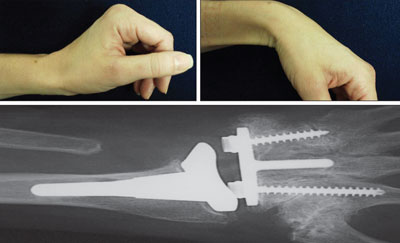Low revision rate found with uncemented total wrist arthroplasty
Uncemented total wrist arthroplasty performed with third generation implants in patients with arthritis showed a 7% revision rate at 5 years, according to a study presented by Robin Kamal, MD, at the 2011 Annual Meeting of the American Society for Surgery of the Hand.
“Our study shows that because the revision rate is so low with the uncemented use of newer generation total wrist implants, potentially, total wrists could be used to treat severe arthritis of the wrist over a wrist fusion, because [total wrists] allow patients to have wrist motion,” Kamal said.
Chart review
Kamal and colleagues at Rhode Island Hospital retrospectively reviewed the charts of 30 patients who underwent total wrist arthroplasty performed by senior surgeon and study researcher, Arnold-Peter C. Weiss, MD, using the third generation Universal 2 implant (Integra; Plainsboro, N.J.).
The study group had an average age of 58 years and included 27 women and three men, according to the study abstract. Patients indicated for surgery had rheumatoid arthritis, juvenile rheumatoid arthritis, psoriatic arthritis or post-traumatic arthritis. The dominant wrist was the wrist affected in 57% of patients.
|
Images: Kamal R |
The group included 27 primary procedures and three revisions of previously cemented total wrist replacements. For the revision procedures, the surgeon first removed all the cement and original implant before performing an uncemented total wrist arthroplasty using the third generation device. Postoperatively, the patients were casted for 4 weeks and then underwent hand therapy.
The average follow-up was 5.1 years, “which is the longest follow-up for uncemented” total wrist arthroplasty, according to Kamal.
Follow-up revealed that patients had 40° active flexion and 28° extension. Radiographs showed that eight patients had evidence of lucency along the carpal component and two patients showed lucency along the radial component. Two patients required revision for carpal implant loosening.
Further study needed
Although some patients in the study reported mild pain, most had no pain. In addition, all of the patients were satisfied.
“We found we had no dislocations and our revision rate was 7%, which is relatively low compared to prior studies that have reviewed total wrist arthroplasties,” Kamal said.
Work remains to determine the long-term efficacy of uncemented total wrist arthroplasty, according to Kamal, but questions still posit whether they are more effective than wrist fusion.
“Our study suggests that uncemented total wrist arthroplasties have a low revision rate and may be a better alternative than wrist fusion. However, more long-term studies and randomized controlled trials need to be completed to discern the advantages and disadvantages as well as patient-reported outcomes of total wrist arthroplasty,” Kamal said. – by Renee Blisard
Reference:
- Cone EB, Kamal R, Weiss AC. Uncemented total wrist arthroplasty: Long-term results. Paper #59. Presented at the 2011 Annual Meeting of the American Society for Surgery of the Hand. Sept. 8-10. Las Vegas.

- Robin Kamal, MD, can be reached at the Department of Orthopedics, Rhode Island Hospital, 593 Eddy St., Providence, RI 02903; 401-444-4000; email: robin_kamal@brown.edu.
- Disclosure: Kamal has no relevant financial disclosures.

